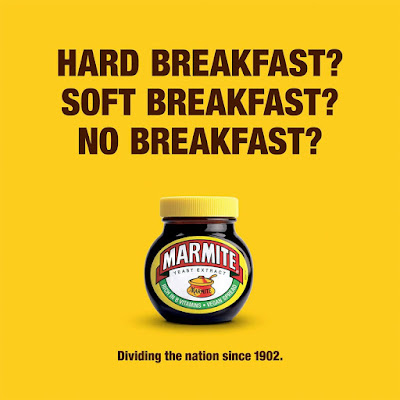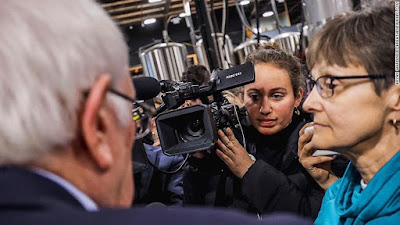Free Beer! Now That I Have Your Attention …
 |
| Source: Adsoftheworld.com |
Read for Nov. 4, 2024. The text chapter this week is on Public Service Advertising and Announcements, but to me, what we’re into this week is writing advertising copy.
Ads: They are all around. We see them all the time, and tend to think, as individuals, we are somehow immune to them. We’re not. Corporations would not pour billions of dollars for more than 150 years into an enterprise if ads hadn’t proven effective over time. Many iconic movements and products owe their success, at least partly, to successful advertising.
Consider, for example, the Volkswagen Beetle. It was a product of Nazi Germany—literally encouraged by Adolph Hitler who wanted a German company to design a “people’s car.” Following the war, as the western world recovered and grew prosperous, the VW Beetle slowly became a global sensation.
Including in the second-most important country (the first was the USSR, the third was the UK) in defeating Nazi Germany.
How did a German company selling a Nazi-inspired product win enough hearts to succeed in America? Well, partly it helps to remember that good ideas can come from evil places—even if Hitler promoted the Beetle, he didn’t create it. It was made by very bright German engineers who brilliantly came up with a subcompact car that had many revolutionary features: A simple, air-cooled engine; a tall body that gave a tiny car surprising interior room (at least in the front, forget the back); and resting the engine on the drive wheels. I think one reason for the Beetle’s success was simply that in the United States, it snows in winter, and in era before front-wheel-drive, having the engine over the drive wheels was a huge advantage in winter.
Plus, the Beetle was promoted in brilliant, ground-breaking ads, like this one from 1960, that emphasized VW was into the quality of the car and not, like American car makers, the looks of the car:
The PSA example in your text shows a video ad using a storyboard format, although it’s the same split table we would use for a video script. More on the structure of ads later. First, true, most advertising is purely marketing, attempting to sell a product or service. But ads can and do serve PR purposes, too.
Consider this ad for, of all things, Oreo cookies:
Other than the emotional connection of the cookie to family and comfort, what does this ad have to do with food? I imagine part of its purpose is simply to position Oreos as a “progressive” product on the right side of history. Which means the ad is mixing marketing and PR goals.
And ads are not all commercials, either. Arguably, YouTube is as important or perhaps more important for getting your word out than all the TV broadcast networks.PR videos can be ads, and can also be “statements” like the MMU COVID-19 playlist I wrote about last week.
And Ads are not just video. VW was famous for it’s print ads in the 1960s, too (the thumbnail on the 1960 VW ad doesn't even appear in the video, it's from a print ad of that era). These days, even as the media world shifts away from print, there are lots of venues for print advertising. If you do PR on a university campus, posters will be an important medium for you. For any organization, the marketplace of ideas is open to you online—and you probably will be thinking “Facebook” for your ads.
Like these:
 |
| Yeah, a VW theme. Above and below, ads from my Facebook feed. |
There are many kinds of ads:
- Marketing ads—to sell a product or service. These are not PR, but their messaging (as with the Oreo ad) can still be important to a company’s PR strategy, and any organization’s marketing has to keep its PR goals in mind, too. If you work in many small organizations, it’s likely that if you’re in PR, you’ll also have to handle marketing (MMU’s PR office is “Marketing and Communications").
- Image ads—to tell the world about the good works your organization does. These are used to improve your reputation. These are definitely PR ads more than marketing ads, sometimes done in the wake of something negative you’re associated with. BP did lots of “green” ads after polluting the whole Gulf of Mexico with its oil rig fire a few years ago, for example. A fair amount of messaging from places like MMU fits into the image category.
- Institutional ads—Similar to image ads, but more to promote the mission or identity of an organization rather than its good deeds.
- Position ads—Kind of the equivalent of an op/ed, these express a point of view on a topic. Of course, you would probably use op/eds too—but the advantage of an ad is that you can completely control the message, and it’s timing and placement. (We haven't covered op/eds yet, but will--they are guest essays published in media to reach an audience, such as writing an opinion column that appears in The Gazette in Cedar Rapids. Op/Ed is newspaper jargon for the page such essays are published on).
 |
| Example of local PR ad--including MMU professor (Dr. Kim Bro) |
Ads fulfill many PR purposes. They can be used to enhance an organization’s image, to build investor or donor relations, as a form of public service (especially the PSA), to advocate on an issue, and to make an announcement (and upcoming event can be promoted with an announcement news release and announcement ads).
Lately, there has been a trend of “native advertising,” which is material that looks like media content, but that is paid for by an organization. This is similar, I suppose, to “product placement” in media (why were all the soda cans in that odd small Oklahoma town in the movie "Twister" all Pepsi cans?). I’m not going to touch on native advertising much more here, but you should know what the term means.
In structure, writing a video ad is the same as writing any video script—it’s going to include the column for video and another for audio. However, with advertising, you don’t have the story-telling structure of the video “package” we worked on last week, so the structure of the ad can vary a lot depending on the message and the audience. Video ads are often mini-adventures, for example: little stories. Advertising is its own writing discipline and I don’t pretend to be an expert on it—but like all professional media, it is very focused on its intended impact on a well-understood audience.
For your writing, I want to spend a bit more time on the “print” ad, partly because it’s going to be part of what I ask you to write this week. I put “print” in quotes, by the way, because this structure I’m going to follow is one you’ll be familiar with from social media—it’s the same structure used for most Facebook ads.
The parts of a print ads are:
- The heading. It can be a headline or a label, but needs to be clever, creative and draw attention. If a reader glances at nothing else, there should be a takeaway from the heading alone. You can have a secondary heading, too—but the main part of the heading writing is developing something short that is attractive to your intended reader.
- The image. This can be a photo, drawing or even just the arrangement of the words themselves—but the ad has to have a compelling look. The image should be consistent with and compliment the heading and ad copy. On Facebook, the image can be an animated gif or short video, as well as the static image. If it’s a poster, magazine ad, newsletter page or newspaper ad, the image, of course, is static. The image needs to both draw attention and help sell the message. Sometimes, the image is a clever or humorous juxtaposition with the words.
- The Copy. “Copy” is media speak for any significant block of words—it’s a term that can be used for a news release, magazine feature or blog post. In this context, the “copy” is the explanatory text that accompanies the heading and image. It can be very short when your message is simple, or may need to be longer. It should be compelling and concise—no wordy writing in any advertising. You must be both clever and parsimonious. Be both an artist and a miser with your words to write ad copy well. By the way, in media terms, the word “copy” is common everywhere, but is most often used in the advertising world—ad agencies even have employees whose title is “copy writer.”
All these elements—heading, image and copy—have to fit seamlessly together in a whole that draws attention and motivates its intended publics.
One of the keys of ad writing is to remember that there is no “just good enough.” There can be no “mail it in” in ad writing. If you’re not on the top of your writing game here, you’re not in the game at all.
It’s just too easy for an ad to be ignored. So, craft ad messages in PR that compel, that are creative and that can be effective.
Other notes about advertising:
- It can be a regulated. Many PR ads are in venues where there are regulatory requirements. Any commercial ad can be challenged if it makes any factual claim that can be proven false—that’s not libel, but it is illegal. As expression, advertising that is “commercial speech” is the most heavily regulated media. Don’t mess around, and never lie, in any product ad.
- It can be ethically dubious. You should believe in your message and sell it hard, but don’t do so with blinders on. It’s too easy for your carefully crafted ad to rub your intended public the wrong way. Consider the very hostile reaction that a Pepsi ad three years ago received. This clip is a bit long, but worth it, I think, because it shows how badly off the rails a PR ad might go if its creators aren’t clear in their purpose and careful in their execution:
Culturally, it’s easy for us to dismiss ads as “lies.” That can be true, especially with bots on social media, but is false in corporate America or in PR. Ads are a key tool that are not beneath you, if you are doing PR for any organization or company.
Final point: PSA is a “public service announcement.” It is an ad, but an ad that depends on the generosity of media for its distribution. You must either be a nonprofit agency or a government agency to even consider using a PSA. Yet, because the nonprofit and government PR worlds are so large, they are a common PR tool.
But, there is no such thing as a Pepsi PSA—because by definition, such a thing cannot exist. A corporation may produce an ad with helpful advice that feels like a PSA, but to use the ad they have to pay for placement like they would with any product ad. Be clear on that point—what a PSA is and who can use it.



Comments
Post a Comment